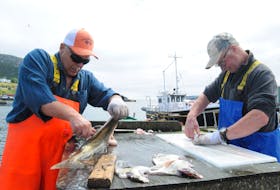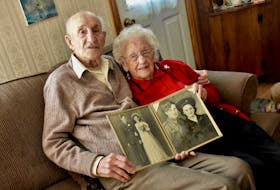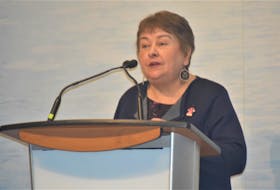The Town of Grand Falls-Windsor is looking to be more efficient in its daily operations.
Earlier this year the town engaged KPMG Consulting to review its operational structure, and offer suggestions for improvement.
That report was completed in August, and was tabled and adopted at the Dec. 3 meeting of council.
"Grand Falls-Windsor has never gone through an exercise like this,” said Grand Falls-Windsor Mayor Barry Manuel. “Since the former towns amalgamated and we became Grand Falls-Windsor officially in 1991, we have seen very little change in our organizational structure.
“Times have changed and the needs of the community have changed and the expectations of the community have changed. We need to adjust accordingly.”
He noted an organization review has been on the minds of municipal leaders for the last three years and was a topic of discussion heading into the municipal elections in 2017.
The 96-page KPMG report lists 21 recommendations for the town, along with a suggested schedule to roll them out.
The report recommends the hiring of a town clerk and a communications officer, as well as realigning the operational makeup of Grand Falls-Windsor and moving from four departments to three.
The three new departments would be corporate services, community services, and public works and development. Fire and municipal services would operate independently.
“The reorganizing is going to allow the CAO position to be more effective because some of these positions that we’re creating is going to take work from the CAO,” said Manuel.
Of course, the town is under no obligation to implement all of what the report recommends, but the mayor indicated there are plans to move ahead on most of them.
“There are three different categories,” said Manuel. “One would be things that can be implemented rather quickly and easily. There are other things that (will) take communication and collaboration with the union to make sure we’re doing things the way they’re supposed to be done.
“And then there are things that come at a cost (and) council ... is going to have to look at these things and decide whether or not the investment is worth what you’re getting.”
It also recommended ways to improve the workplace environment, noting during the consultation and review process there were comments made about low staff morale.
In order to reach its conclusions, KPMG used data from the town up to June 7 of this year and conducted interviews with staff.
The consultants also compared Grand Falls-Windsor to similar communities in both Newfoundland and Labrador and Nova Scotia. The comparable towns were: Gander, Conception Bay South and Corner Brook, NL; and Truro, NS.
“Change is good, but change is always something that comes about with some resistance and maybe some criticism,” said Manuel. “I think if everyone gives it a fair, objective effort then it is going to translate into positive results for the town and our residents.
“That means it will be good for everybody ... and that bodes well for our future.”
The entire report can be viewed online here.
Recommendations:
• Establish a formalized strategic plan which clearly outlines the town’s mission, vision, and strategic objectives or goals. The town’s strategic plan should be communicated across the entire organization;
• Develop a set of KPIs (no more than six) to monitor town performance against established strategic goals;
• Standardize the town's management structure across all departments and business units so there is a greater understanding and clarity of the organization’s management;
• Establish a deputy town clerk position, reporting to the director of corporate services, and responsible for the statutory duties of clerk under the Municipalities Act;
• As described in the detailed organizational structure, combine the town’s administrative functions (HR, finance, procurement, occupational health and safety, IT) into a single department called corporate services;
• Combine the town’s community services and economic development into a single department called community services;
• Combine the town’s engineering, public works, and park and recreation operation services into a single department called public works and development;
• Establish a communications officer position, reporting to the CAO. The position would be responsible for communicating decisions of council, communicating changes in service delivery, responding to public inquiries, and ensuring consistent messaging on websites, social media, press releases and through any other communication channels;
• Have the town’s seven current dispatchers work with the communications officer to respond to inquiries on municipal services either through phone, email or social media channels;
• Committee meetings should be limited to two hours for efficiency. Council appoints committees so it should be respectful of the councillors' committee responsibilities. Councillors are not required to attend committees if they are not members of the respective committee. Consensus on any recommendations is based on committee members;
• Invest in an Enterprise Resource Planning (ERP) system that is standard for municipal operations and consistent with the town’s size;
• Outsource GIS services to a private sector provider who can provide and manage a GIS platform for the town at an approximate cost of $30,000 per year;
• Move all vendors and employees to direct deposit payments.
Alter payroll to bi-weekly payment;
• Institute signing thresholds for purchasing processes;
• As per Section 79 of the Municipalities Act, establish operating and capital stabilization reserves. For the operational stabilization reserve any net operational results will be transferred to/from the operating stabilization reserve at year end. For the capital stabilization reserve, budget variances resulting from approved capital projects will be funded from/contribute to the H M capital stabilization reserve;
• Implement a life-cycle funding model for the town’s fleet and equipment. An annual levy of $750,000 to fund an equipment reserve is recommended. It is further recommended the town reduce the size of the fleet so the required annual life-cycle funding falls to $750,000;
• The town should develop an investment policy to maximize the return on its investments in accordance with the appropriate level of risk as established by the Municipalities Act;
• The town should reinforce the importance of consistent HR practices with all department heads, especially in the areas of hiring, performance management and leave requests;
• Implement a job evaluation system for the town’s management positions;
• Develop a formalized performance evaluation system for unionized employees and management;
• Identify key functions/processes that have potential to create service bottlenecks. Cross-train employees for these functions and processes to ensure town services are maintained at a high level during periods of employee absence;
• Continue recent initiatives to improve the workplace culture so employees can feel secure and capable of achieving success. Ensure that union-management meetings occur regularly, and meetings are not rescheduled unless absolutely necessary. Regular agendas and minutes should be prepared for each union-management meeting.









